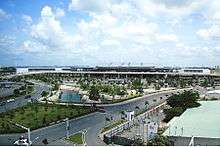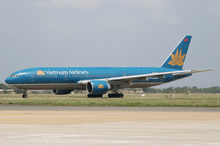Tân Sơn Nhất International Airport
| Tân Sơn Nhất International Airport Sân bay Quốc tế Tân Sơn Nhất | |||||||||||||||
|---|---|---|---|---|---|---|---|---|---|---|---|---|---|---|---|
|
| |||||||||||||||
 | |||||||||||||||
| IATA: SGN – ICAO: VVTS | |||||||||||||||
| Summary | |||||||||||||||
| Airport type | Public / Military | ||||||||||||||
| Owner | Vietnamese government | ||||||||||||||
| Operator | Airports Corporation of Vietnam | ||||||||||||||
| Serves | Ho Chi Minh City, Vietnam | ||||||||||||||
| Location | Tan Binh District | ||||||||||||||
| Hub for | |||||||||||||||
| Elevation AMSL | 10 m / 33 ft | ||||||||||||||
| Coordinates | 10°49′08″N 106°39′07″E / 10.81889°N 106.65194°ECoordinates: 10°49′08″N 106°39′07″E / 10.81889°N 106.65194°E | ||||||||||||||
| Website | http://tansonnhatairport.vn | ||||||||||||||
| Map | |||||||||||||||
 SGN Location of the airport in Vietnam | |||||||||||||||
| Runways | |||||||||||||||
| |||||||||||||||
| Statistics (2015) | |||||||||||||||
| |||||||||||||||
|
Source: ACV [1] | |||||||||||||||
Tân Sơn Nhất International Airport (IATA: SGN, ICAO: VVTS) (Vietnamese: Sân bay quốc tế Tân Sơn Nhất, Vietnamese: Cảng hàng không quốc tế Tân Sơn Nhất) is Vietnam's largest international airport in terms of area (850 ha or 2,100 acres compared with 650 ha or 1,606 acres of Ha Noi's Nội Bài International Airport and Đà Nẵng's Đà Nẵng International Airport[2][3]). After recent expansion to meet increasing demand, it currently has a handling capacity of 25 million passengers per year,[4] compared with the capacity of Hanoi – Noi Bai airport of 19 million passengers and Da Nang's 6 million passengers.[3] It is also the largest airport of Vietnam and one of the top 50 busiest airports in the world in terms of passengers handled with over 26 million passengers in 2015,[1] serving Ho Chi Minh City as well as the rest of southeastern Vietnam. Its IATA code, SGN, is derived from the city's former name of Saigon.
History
Tan Son Nhat International Airport has its origins in the early 1930s, when the French colonial government constructed a small airport with unpaved runways, known as Tân Sơn Nhất Airfield near the village of Tan Son Nhat. By mid-1956, with U.S. aid, a 7,200-foot (2,190 m) runway had been built and the airfield near Saigon became known as South Vietnam's principal international gateway. During the Vietnam War (or Second Indochina War), Tan Son Nhut Air Base (then using the alternative spelling Tân Sơn Nhứt) was an important facility for both the U.S. Air Force and the South Vietnamese Air Force. Between 1968 and 1974, Tan Son Nhut Airport was one of the busiest military airbases in the world. During the last days of South Vietnam, Pan Am schedules from 1973 showed Boeing 747 service was being operated four times a week to San Francisco via Guam and Manila.[5] Continental Airlines operated up to 30 Boeing 707 military charters per week to and from Tan Son Nhut Airport during the 1968–74 period.[6]
Post-war era
On 9 December 2004, United Airlines became the first U.S. airline to fly to Vietnam since Pan Am's last flight during the Fall of Saigon in April 1975. Flight UA 869, operated using a Boeing 747-400, landed at Ho Chi Minh City, the terminus of the flight that originated from San Francisco via Hong Kong. On 29 October 2006, this service was switched from San Francisco to Los Angeles with a stop in Hong Kong, operating as UA 867 (also using a Boeing 747-400). In 2009, the service UA 869 has resumed once again from San Francisco via Hong Kong International Airport.[7] United ceased the route to San Francisco via Hong Kong on 30 October 2011. The airline resumed the route from Ho Chi Minh City to Hong Kong after its merger with Continental Airlines. It no longer continued to San Francisco and it was flown on a Boeing 777 instead of a 747.
In 2006, Tan Son Nhat International Airport served approximately 8.5 million passengers (compared with 7 million in 2005) with 64,000 aircraft movements.[8] It has recently accounted for nearly two-thirds of the arrivals and departures at Vietnam's international gateway airports.[9][10] Due to increasing demand (about 15–20% per annum), the airport has been continuously expanded by the Southern Airports Corporation.[10]
Tan Son Nhat International Airport served 12.4 million passengers in 2008, compared to 11 million in 2007 and 15.5 million passenger in 2010. In 2010, the domestic terminal handled 8 million passengers which reached its maximum capacity. The airport reached its full capacity of 20 million passengers in 2013, two years earlier than predicted. Both domestic and international terminal are being expanded to meet the increasing demand. In December 2014, expansion for the domestic terminal was finished, boosting the terminal's capacity to 13 million passengers per annum.[11] The expansion plan also includes increasing the capacity of the international terminal up to 13 million passengers per year, 10 new parking spaces and a new taxiway. After extension, planned to be completed in 2015, Tan Son Nhat will be able to handle 25 million passengers per year with space for 60 aircraft.[12]
International terminal

A new international terminal funded by Japanese official development assistance and constructed by a consortium of four Japanese contractors (KTOM, abbreviation of four contractors' names: Kajima – Taisei – Obayashi – Maeda), opened in September 2007 with a capacity for 12 million passengers a year. The new terminal gives the airport a total annual capacity of 20 million passengers. The old terminal is now used for domestic flights.[2] After 2020, when Long Thanh International Airport is completed, Tan Son Nhat will remain operational; however, it will mostly serve for domestic flights, a few international flights and no longer serve transit flights.
Facilities
Following the opening of its new international terminal in September 2007, Tan Son Nhat has two major terminal buildings with separate sections for international and domestic flights. The capacity of the new terminal, once fully completed, will be 8 million passengers per annum. When Long Thanh International Airport is completed, Tan Son Nhat will serve domestic passengers only.
The Prime Minister of Vietnam, by Decision 1646/TTg-NN, has approved the addition of 40 hectares (99 acres) of adjacent area to extend the apron and to build a cargo terminal to handle the rapid increase of passenger (expected to reach 17 million in 2010, compared to 7 million and 8.5 million in 2005 and 2006 respectively) and cargo volume at the airport.[9][13]
Airlines and destinations



Passenger
1: Beginning 27 June 2016, Turkish Airlines's flight from Ho Chi Minh City to Istanbul will make a stop or continue on to Hanoi. Turkish Airlines, however, will not have eighth freedom traffic rights to transport passengers solely from Ho Chi Minh City to Hanoi.
Cargo
Statistics
|
|
The airport's future
Tan Son Nhat International Airport is located inside the crowded city of Ho Chi Minh City, making expansions difficult.
Following a recent decision by the Vietnamese Prime Minister, a new airport—Long Thanh International Airport—will replace Tan Son Nhat airport for international departure use. The master plan for the new airport was approved in April 2006. The new airport will be built in Long Thanh county, Dong Nai province, about 50 km (31 mi) northeast of Ho Chi Minh City and 70 km (43 mi) northwest of the petroleum-focused city of Vung Tau, near Highway 51A.
Long Thanh International Airport will be constructed on an area of 50 square kilometers (19 sq mi), and will have four runways (4,000 m x 60 m or 13,100 ft x 200 ft) and be capable of receiving the Airbus A380. The project will be divided in two stages. Stage One calls for the construction of two parallel runways and a terminal with a capacity of 20 million passengers per year, due to be completed in 2020. Stage Two is scheduled for completion in 2035, giving the airport with three passenger terminals and a cargo terminal designed to receive 5 million metric tons of cargo per year. The total invested capital of this project is an estimated US$8 billion.
Upon completion of Long Thanh International Airport, Tan Son Nhat Airport will serve domestic passengers only. Long Thanh International Airport is expected to be the leading airport on the Indochinese peninsula, and one of the busiest air transportation hubs in the southeast Asian region.[24]
See also
- Bombing of Tan Son Nhut Air Base
- Da Nang International Airport
- Long Thanh International Airport
- Noi Bai International Airport
- List of airports in Vietnam
References
- 1 2 "2015 Statistics of ACV". vietnamairport.vn. Airports Corporation of Vietnam. Retrieved 19 January 2016.
- 1 2 Official website of Tan Son Nhat International Airport
- 1 2 Vietnam Aviation Magazine (Tạp chí Hàng không), October 2007 issue (a magazine published by the Vietnam Aviation Authority), in article Is that possible for a new international airport in Hai Duong Province ?
- ↑ "Tan Son Nhat International Airport". Airports Corporation of Vietnam. Retrieved 30 April 2014.
- ↑ Pan Am System Timetable, April 29, 1973
- ↑ Christian, J. Scott, former Continental employee and manager, Bring Songs to the Sky: Recollections of Continental Airlines, 1970–1986, Quadran Press, 1998.
- ↑ United Airlines – Flight Timetables, Download to PC, PDA or Blackberry
- ↑ Official number from Tan Son Nhat Airport Authority at its official website
- 1 2 Two more Hanoi<>Saigon flights per day for Pacific Airlines on "Vietnamnet.net, access date 11 November 2007, (Vietnamese)
- 1 2 News about Tan Son Nhat International Airport on Official Website of Ministry of Transport of Vietnam, 12 November 2007, Vietnamese Archived 12 November 2007 at the Wayback Machine
- ↑ "Sân bay Tân Sơn Nhất tăng năng lực phục vụ". nld.com.vn. Người Lao Động. Retrieved 7 January 2015.
|first1=missing|last1=in Authors list (help) - ↑ Lê, Anh. "Tân Sơn Nhất có thêm đất làm sân đỗ máy bay". Thời báo Kinh tế Sài Gòn. Retrieved 30 April 2014.
- ↑ Two more Hanoi–Saigon flights per day for Pacific Airlines on "Vietnamnet.net, access date 11 November 2007, (English)
- ↑ "Air New Zealand to Start Seasonal Ho Chi Minh Service from June 2016". airlineroute. Retrieved 24 January 2016.
- 1 2 "Breakfast @ Tuoi Tre News – April 16". Tuoi Tre News.
- ↑ http://airlineroute.net/2014/09/16/ae-khh-w14/
- ↑ "Nok Air Launches New Route from Bangkok to Ho Chi Minh city". Retrieved 16 July 2015.
- ↑ http://www.anna.aero/2015/09/16/sichuan-airlines-sets-off-south-korea-vietnam/
- ↑ http://airlineroute.net/2015/10/30/tw-icnsgn-dec15/
- ↑ fly-on-vietjetairs-new-route-from-ho-chi-minh-city-to-buon-me-thuot-for-just-vnd390000 – news – VietJetAir.com – Enjoy Flying!. VietJetAir.com. Retrieved on 16 July 2013.
- ↑ http://www.ttrweekly.com/site/2015/09/vietjet-adds-domestic-routes/
- ↑ http://baotintuc.vn/doanh-nghiep/bay-han-quoc-myanmar-0-dong-cung-vietjet-20150721124348892.htm
- ↑ "2005-2014 Statistics of Tan Son Nhat Intl Airport". www.caa.mt.gov.vn. Civil Aviation Authority of Vietnam. Retrieved 22 January 2015.
- ↑ Củng cố luận chứng xây dựng sân bay Long Thành, Tiên Lãng – Website thông tin Hàng không & Cuộc sống
External links
| Wikimedia Commons has media related to Tân Sơn Nhất International Airport. |
- Tan Son Nhat Airport Official Website
- Southern Airports Corporation Official Website (SAC)
- Saigon Ground Services official website, a subsidiary of SAC
- Tan Son Nhat International Airport Ground Services (TIAGS) official website; a subsidiary of Vietnam Airlines
- Tan Son Nhat airport – Terminals
- Airport information for VVTS at World Aero Data. Data current as of October 2006.
- News Item on Fire at Airport on Monday 27 October 2008
| ||||||||||||||||||